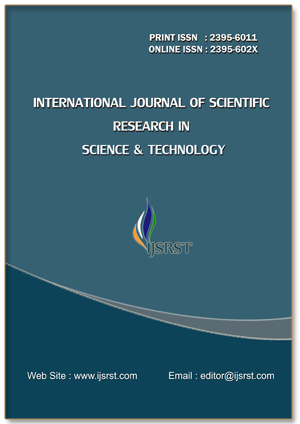Insilico Analysis and Screening of Novel Target for Beta1, 3 Glucanase D Involved In Red Rot
Keywords:
Red rot, Colletotrichum Falcatum, Homology Modling, Ramachandran Plot, Red Rot of Sugarcane, Drug targets, Swiss-Model, Molecular DockingAbstract
Sugarcane (Saccharum officinarum) is avital cash crop and agro-industrial product, especially in India, which is one of the largest producers and consumers of sugar. However, its cultivation is severely affected by various diseases, with red rot—caused by the fungal pathogen Colletotrichum falcatum—being one of the most destructive. This disease, often referred to as the "cancer of sugarcane," leads to major losses in both yield and quality. The fungus is highly variable in nature, which frequently leads to the failure of resistant varieties due to the emergence of new, more virulent strains. Red rot has been reported for over a century in many sugarcane-growing countries including India, Java, Argentina, and the USA. Despite efforts like hybridization between cultivated sugarcane and wild species to breed resistant varieties, periodic outbreaks have occurred due to the widespread cultivation of a single variety and the breakdown of resistance over time. To understand the biology of C.falcatum and aid in disease management, this study focused on identifying and modeling potential drug target proteins from the pathogen. A protein sequences were retrieved from the UniProt database, and 3D structural models were developed using tools like Swiss Model and BLASTp. models were validated as significant using Ramachandran plot analysis. This dataset of protein structures could be a valuable resource for targeted drugdiscovery and development of antifungal treatments for managing red rot disease in sugarcane. Additionally, recent genomic and transcriptomic studies on C. falcatum have identified potential effector genes and pathogenicity hotspots, which can support future efforts in genetic improvement and integrated disease management strategies. Other approaches including bioagents, chemical treatments, and mechanized sett treatments are also showing promising results in controlling the disease in the field.
📊 Article Downloads
References
Dixon,R.A.,Ferreira,D.,&Peer,W. A. (2018). Biofuels and bioproducts from sugarcane. Annual Review of Plant Biology, 69, 149–172.
Effect of red rot on cane yield and sugar recovery in sugarcane. Pakistan Sugar Journal, 1(2), 3–7.
Menossi, M., Silva-Filho, M. C., Vincentz, M., Van Sluys, M. A., & Souza, G. M. (2008). Sugarcane functional genomics: Gene discovery for agronomic trait development. International Journal of Plant Genomics, 2008, 1–11.
Souza,G.M.,Berges,H.,Bocs,S., Casu,R.,D’Hont,A.,Ferreira,J.E.,... &Vincentz,M.(2017).Thesugarcane genome challenge: Strategies for sequencing a highly complex genome. Tropical Plant Biology, 10(1), 3–17.
Viswanathan, R. (2021). Management of red rot disease in sugarcane – challenges and prospects. Sugar Tech, 23(3), 552–564.
Dixon,R.A.,etal.(2018)."Sugarcane as a sustainable bioenergy crop." Renewable and Sustainable Energy Reviews, 82(1), 64-77.Liu,Y., et al. (2017). "The role of beta-1,3- glucanases in plant immunity." Plant Science Reviews, 44(6), 208-219.
JulienMHR,IrvineJE,BendaGTA. Sugarcane anatomy, morphology andphysiology.In:RicaudC,Egan ET,GillaspieJrAG,HughesCG, editors. Diseases of sugarcane: major diseases. Amsterdam: Elsevier; 1989. p. 1–20.
Menossi M, Silva-Filho MC, VincentzM,Van-SluysMA,Souza GM. Sugarcane functional genomics: gene discovery for agronomic trait development. Int J Plant Genom. 2008; 2008:1–11. doi: 10.1155/2008/458732.
Singh RP, Lal S 2000 Red rot In A Guide to Sugarcane Diseases Ed P Rott,RABailey,JCComstock,BJ Croft, AS Saumtally, CIRAD/ ISSCT, Montpellier, France, 153- 158 pages.
Viswanathan R 2010 Plant Disease Red Rot of Sugarcane, Anmol Publishers, New Delhi, India.
JulienMHR,IrvineJE,BendaGTA. Sugarcane anatomy, morphology andphysiology.In:RicaudC,Egan ET, Gill as pie Jr AG, Hughes CG, editors. Diseases of sugarcane: major diseases. Amsterdam: Elsevier; 1989. p. 1–20.
Menossi M, Silva-Filho MC,VincentzM,Van-Sluys MA,Souza GM. Sugarcane functional genomics: gene discovery for agronomic trait development. Int J Plant Genom.2008;2008:1–11.doi: 10.1155/2008/458732.
SouzaTP,DiasRO,Silva-FilhoMC. Defense-related proteins involvedin sugarcane responses to biotic stress. Genet Mol Biol. 2017; 40:360–372.doi:10.1590/1678-4685-gmb2016-0057.
preachbio.com/2024/03/understanding- red-rot-of-sugarcane.html
www.cabi.org/isc/datasheet/25361#toDistributionMaps
Abbott EV. Red rot of sugarcane. Technical Bulletin, USDA 1938;641:96.
Edgerton CW, Tims EC, Mills PJ. Stubble deterioration of sugarcane. Louisiana Agricultural Experiment Station Bulletin 1934;256:27.
Downloads
Published
Issue
Section
License
Copyright (c) 2025 International Journal of Scientific Research in Science and Technology

This work is licensed under a Creative Commons Attribution 4.0 International License.
https://creativecommons.org/licenses/by/4.0




